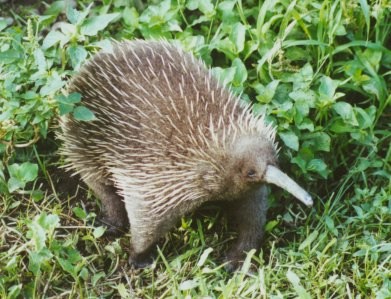- Echidna
Taxobox
name = EchidnasMSW3 Groves|pages=p. 1-2|id=10300002]

image_caption =Western Long-beaked Echidna
regnum =Animal ia
phylum = Chordata
classis =Mammal ia
ordo =Monotremata
familia = Tachyglossidae
familia_authority = Gill, 1872
subdivision_ranks =Species
subdivision = Genus "Tachyglossus " "T. aculeatus" Genus "Zaglossus " "Z. attenboroughi" "Z. bruijnii" "Z. bartoni" †"Z. hacketti" †"Z. robustus" Genus †"Megalibgwilia " †"M. ramsayi" †"M. robusta"French Island echidna building a defensive burrow (0:43s)
21 October 2007 ] are four extantmammal species belonging to the Tachyglossidae family of themonotreme s. Together with thePlatypus , they are the only surviving members of that order. Although their diet consists largely of ants and termites, they are not actually related to theanteater species. They live inNew Guinea andAustralia . The echidnas are named after a monster in ancient Greek mythology.Description
Echidnas are small mammals that are covered with coarse
hair and spines. Superficially they resemble the anteaters of South America, and other spiny mammals likehedgehog s andporcupine s. They have snouts which have the functions of both the mouth and nose. Their snouts are elongated and slender. They have very short, strong limbs with largeclaw s and are powerful diggers. Echidnas have a tinymouth and a toothlessjaw . They feed by tearing open soft logs,anthill s and the like, and use their long, stickytongue which protrudes from their snout to collect their prey. TheShort-beaked Echidna 's diet consists largely of ants and termites, while the "Zaglossus" species typically eat worms and insect larvae.The long-beaked echidnas have tiny spines on their tongues that help capture their meals.
Echidnas and the Platypus are the only egg-laying mammals, known as monotremes. The female lays a single soft-shelled, leathery egg twenty-two days after mating and deposits it directly into her pouch. Hatching takes ten days; the young echidna, called a
puggle , then sucksmilk from the pores of the two milk patches (monotremes have nonipple s) and remains in the pouch for forty-five to fifty-five days, at which time it starts to develop spines. The mother digs a nursery burrow and deposits the puggle, returning every five days to suckle it until it is weaned at seven months.Male echidnas have a four-headed
penis , but only two of the heads are used during mating. The other two heads "shut down" and do not grow in size. The heads used are swapped each time the mammal copulates. [cite web | author = Shultz, N. | date =2007-10-26 | url = http://environment.newscientist.com/article.ns?id=dn12838 | title = Exhibitionist spiny anteater reveals bizarre penis | work =New Scientist [http://www.newscientist.com/home.ns website] | accessdate = 2006-10-27]Taxonomy
Echidnas are classified into three genera. The "
Zaglossus " genus includes three extantspecies and two species known only fromfossil s, while only one species from the genus "Tachyglossus " is known. The third genus, "Megalibgwilia ", is only known from fossils."Zaglossus"
The three living "Zaglossus" species are endemic to
New Guinea . They are rare and are hunted for food. They forage in leaf litter on the forest floor, eatingearthworm s andinsect s. The species are:*the
Western Long-beaked Echidna ("Zaglossus bruijni") of the highlandforest s
*Sir David's Long-beaked Echidna ("Zaglossus attenboroughi"), recently discovered, prefers a still higher habitat
*theEastern Long-beaked Echidna ("Zaglossus bartoni"), of which four distinct subspecies have been identifiedThe two fossil species are:
*"Zaglossus robustus"
*"Zaglossus hacketti""Tachyglossus"
The
Short-beaked Echidna ("Tachyglossus aculeatus") is found in southeastNew Guinea and also occurs in almost allAustralia n environments, from the snow-cladAustralian Alps to the deepdesert s of theOutback , essentially anywhere that ants and termites are available. Its size is smaller than the "Zaglossus" species, and it has longer hair."Megalibgwilia"
The genus "
Megalibgwilia " is only known from fossils:*"Megalibgwilia ramsayi" from
Late Pleistocene sites in Australia
*"Megalibgwilia robusta" fromMiocene sites in AustraliaReferences
* Flannery, T.F. and Groves, C.P. (1998) A revision of the genus "Zaglossus" (Monotremata, Tachyglossidae), with description of new species and subspecies. "Mammalia" 62, 367-396.
* Parker, J., " [http://www.abc.net.au/science/scribblygum/June2000/default.htm Echidna Love Trains] ", "Scribbly Gum" online magazine.
* Rismiller, P., " [http://www.earthwatch.org/site/pp2.asp?c=dsJSK6PFJnH&b=1147621 Echidnas and Goannas of Kangaroo Island] ", Earthwatch Institute.External links
* [http://www.nwf.org/nationalwildlife/article.cfm?articleId=763&issueId=61 "The Enigma of the Echidna"] by Doug Stewart, "National Wildlife," April/May 2003.
* [http://www.abc.net.au/science/scribblygum/June2000/default.htm Scribbly Gum - Australian Broadcasting Corporation online magazine] , article "Echidna Love Trains": Echidna spotting, Trains (breeding behaviour), The amazing puggle (young), Species, Dreaming (REM sleep), Managing populations; June 2000
Wikimedia Foundation. 2010.
